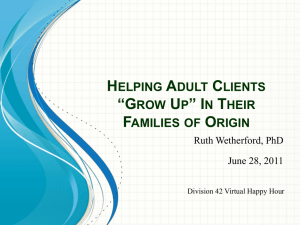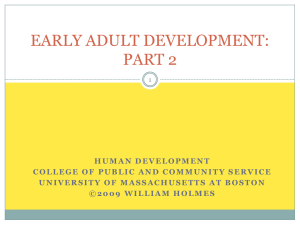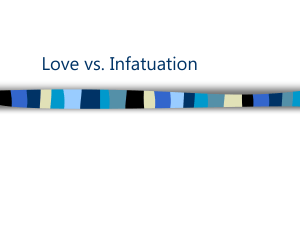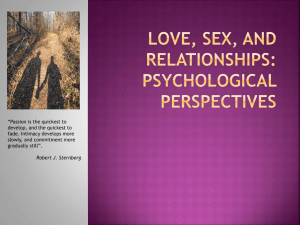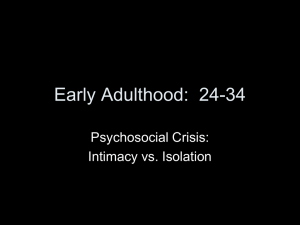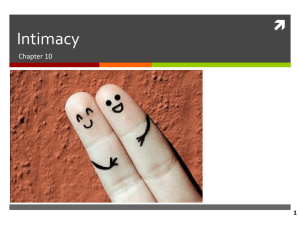Chapter 10 Notes
advertisement
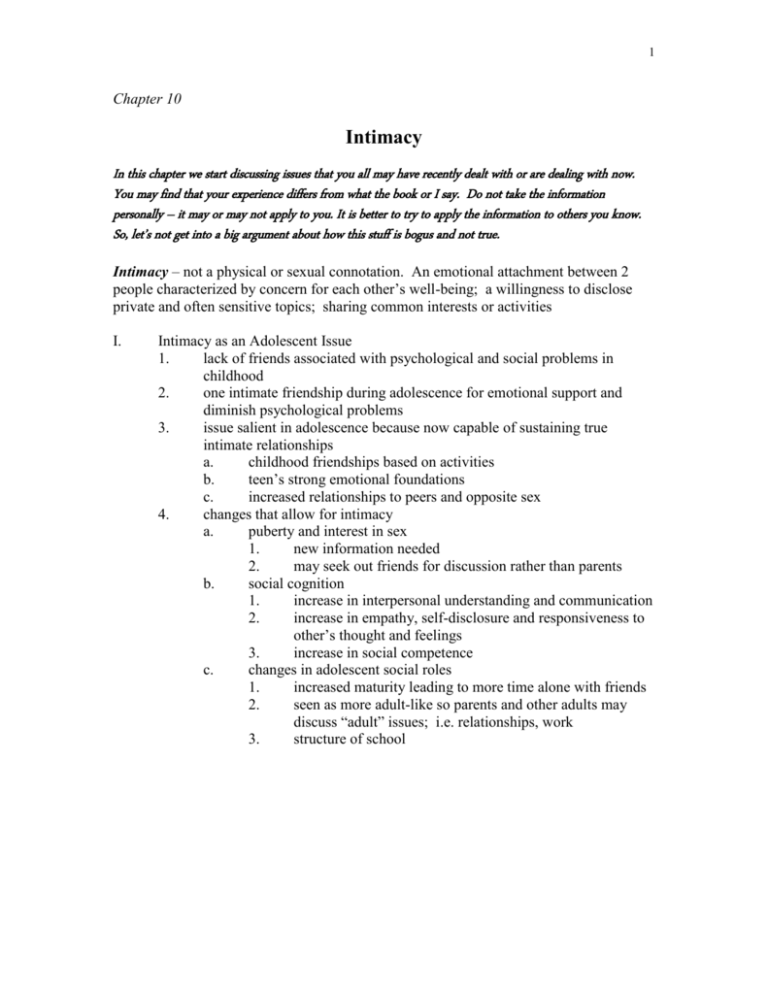
1 Chapter 10 Intimacy In this chapter we start discussing issues that you all may have recently dealt with or are dealing with now. You may find that your experience differs from what the book or I say. Do not take the information personally – it may or may not apply to you. It is better to try to apply the information to others you know. So, let’s not get into a big argument about how this stuff is bogus and not true. Intimacy – not a physical or sexual connotation. An emotional attachment between 2 people characterized by concern for each other’s well-being; a willingness to disclose private and often sensitive topics; sharing common interests or activities I. Intimacy as an Adolescent Issue 1. lack of friends associated with psychological and social problems in childhood 2. one intimate friendship during adolescence for emotional support and diminish psychological problems 3. issue salient in adolescence because now capable of sustaining true intimate relationships a. childhood friendships based on activities b. teen’s strong emotional foundations c. increased relationships to peers and opposite sex 4. changes that allow for intimacy a. puberty and interest in sex 1. new information needed 2. may seek out friends for discussion rather than parents b. social cognition 1. increase in interpersonal understanding and communication 2. increase in empathy, self-disclosure and responsiveness to other’s thought and feelings 3. increase in social competence c. changes in adolescent social roles 1. increased maturity leading to more time alone with friends 2. seen as more adult-like so parents and other adults may discuss “adult” issues; i.e. relationships, work 3. structure of school 2 II. Theoretical Perspectives A. Sullivan’s Theory of Interpersonal Development 1. security<-> anxiety needs being satisfied vs needs not being satisfied (frustrated) 2. Developmental Epochs Infancy (0-3) Need for contact and tenderness Childhood (3–7) Need for adult participation Juvenile (7–10) Need for peers and peer acceptance Preadolescence (10–14) Need for intimacy and consensual validation (by same sex) Early Adolescence (14–17) Need for sexual contact and intimacy with opposite sex peers Late Adolescence (17–18) Need for integration into adult society 3. B. C. psychosocial development is cumulative a. gradually builds up satisfying relationships b. “glue” that holds self-identity together Erikson’s view of intimacy 1. identity vs identity diffusion 2. intimacy vs isolation 3. one cannot go on to intimacy without first establishing and identity 4. one can look intimate; i.e. going steady; look like you talk but hold back -> pseudointimacy attachment in adolescence 1. attachment – strong emotional bond that is enduring and persistent; formed over time 2. 3 types a. secure attachment – trust b. anxious-avoidant – indifference c. anxious-resistant – ambivalence 4. influential for 2 reasons a. internal-working model – a model of interpersonal relationships that is either trusting or apprehensive of intimate relationships b. attachment relationships are cumulative 1. securely attached children have more positive relationships up to and into adulthood 2. poor attachment in childhood can lead to poor peer relationships and decreased social competence 3 III. Research on the Development of Intimacy A. Changes in friendships 1. most common in childhood: a. play and association; we play ball b. prosocial behavior (we help each other) 2. late childhood, early adolescence a. intimacy and trust (we tell secrets) b. loyal support (we stick together) 3. intimacy becomes a defining aspect of friendship 4. middle adolescent girls show unique change -> loyalty and anxiety over rejection; not present in older or younger girls, just the ones in the middle a. stress security in friendships b. friend must b loyal and trustworthy; reliable source of support in an emotional crisis c. cannot abandon you d. or gossip behind your back e. invest heavily in this relationship f. very dependent on it B. Changes in display of intimacy 1. actual displays increase 2. friendships become more personal with personal knowledge (information about and feelings of other) 3. become more responsive toward friends 4. more physically and psychologically responsive where behavior and feelings both more in synch 5. increase in interpersonal sensitivity; i.e. empathy and social understanding C. changes in “targets” of intimacy 1. peers increasingly object of intimacy 2. parents decline only slightly then are reestablished in late adolescence 3. peers and parents both important; each necessary for normal, healthy development 4. siblings and extended family typically not intimate (grandparents?) D. Same sex vs opposite sex friendships 1. reasons for same sex preference in preadolescence and early adolescence a. boys and girls engage in different activities and have different interests b. discomfort with perception that if you talk to opposite sex you’re going together 2. much teasing, joking around and anxiety over interactions with opposite sex 3. movement into mixed sex crowds 4 4. 5. opposite sex person rarely listed as significant person for later intimate relationships it seems more important that boys have an intimate friendship with a girl; not as important for girls IV. Intimacy and Psychosocial Development A. Function of close relationships 1. benefits a. friends used to discuss future plans; careers, relationships, dreams, lifestyle b. central to adolescent mental health c. increases self-esteem d. role in adult socialization and sex role appropriateness e. sexual socialization; how to act with the opposite sex 2. negative effects a. too much conversation about problems and issues may lead to excessive introspection and self-consciousness b. antisocial values may be stressed B. Adolescent loneliness 1. new capacity and desire for intimacy may not be accompanied by sufficient social relationships or supports 2. crowds and cliques diminish into adulthood 3. high school – may not have similar schedule as friends 4. changing schools or going off to college results in lost relationships 5. college students who lower their expectations about forming social relationships are more lonely V. Opposite Sex Relationships A. Dating and romantic relationships 1. girls enter relationships with more knowledge of intimacy and closeness 2. boys develop these skills more through dating 3. boys date at a later age generally than do girls with most boys dating by age 16 4. rather than creating intimacy, dating seems to foster superficiality; shallow sociability and pseudointimacy 5. early serious dating with one guy seems more negative for girls a. more pressure to have sex b. stress on social status c. less mature, less imaginative and more superficial 6. not dating is also bad a. excessive dependency on parents b. insecurity c. less popular d. poorer self-image 5 B. C. e. lower acceptance by friends 7. patterns of relating learned at home by watching parents; i.e. resolving conflicts 8. dating now an end to itself, not a part of courtship or mate selection as it was in 1950s Breaking up 1. very difficult to stay together once off at college 2. factors related to remaining together a. high levels of intimacy and love b. equal commitment to each other c. high similarity age, educational plans, SAT scores, and physical attractiveness d. similarities in religious beliefs and social class were NOT good predictors 3. break ups most likely in May and June, Sept., and Dec-Jan. 4. easier and less depressing to be the break-upper than the breakupee (dumper rather than dumpee) Adolescent marriage and divorce 1. trend toward delaying marriage a. 60s & 70s: 1 in 10 teen women married b. 1986: 1 in 20 teen women married c. 1993: average man 26.5 years average woman 24.5 years 2. divorce rates: men who marry in teens are 3X higher to divorce women who marry in teens are 4X higher to divorce 3. factors related to divorce a. premarital pregnancy b. economic stress c. low level of education (poor job) all of which are higher in teen marriages 4. factors related to marital success a. long standing relationship before marriage b. delaying pregnancy at least 1 year c. finishing high school
